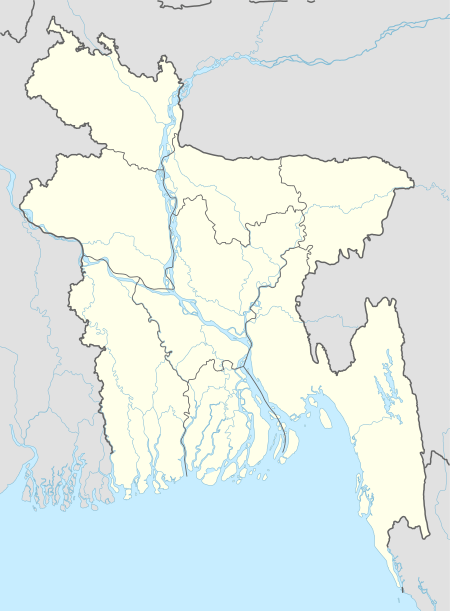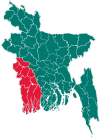Shailkupa Upazila
Shailkupa (Bengali: শৈলকুপা) is an Upazila of Jhenaidah District in the Division of Khulna, Bangladesh.
Shailkupa | |
|---|---|
City, Sub Division | |
 Shailkupa Location in Bangladesh | |
| Coordinates: 23°41.5′N 89°15′E | |
| Country | |
| Division | Khulna Division |
| District | Jhenaidah District |
| Area | |
| • Total | 373.42 km2 (144.18 sq mi) |
| Population (2011) | |
| • Total | 361,648 |
| • Density | 970/km2 (2,500/sq mi) |
| Time zone | UTC+6 (BST) |
| Website | shailkupa.jhenaidah.gov.bd |
Geography
It has a total area of 373.42 km². It is located in between 23°34' and 23°46' north latitudes and in between 89°07' and 89°23' east longitudes. It is bounded by Khoksa and Kumarkhali sub-districts on the north, Jhenaidah Sadar and Magura Sadar sub-districts on the south, Pangsha and Sreepur (Magura) sub-districts on the east, Kushtia Sadar and Harinakunda sub-districts on the west.[1]
Demographics
According to the 2011 Bangladesh census, Shailkupa had a population of 361,648. Males constituted 49.99% of the population and females 50.01%. Muslims formed 89.07% of the population, Hindus 10.76%, Christians 0.03% and others 0.15%. Shailkupa had a literacy rate of 47.18% for the population 7 years and above.[2]
It has 51,595 households. As of the 1991 Bangladesh census, Shailkupa has a population of 293,341. Males constitute 51.43% of the population, and females 48.57%. The adult population numbers 151,516. Shailkupa has an average literacy rate of 66.3% (7+ years) compared to the national average of 32.4%.[3]
History
In the Pleistocene era, in the middle of the formation of the land of Bangladesh, the land formed in this region by the sandy soil of the Ganga River of the Bengal delta and the settlement of people continued to grow. Although there is no significant information about the prehistoric period, the first human settlement was developed in this area in the second millennium BC. In ancient times, people of various ethnic groups started to live in search of a fertile land for livelihood and developed human habitation here. In the anthropological analysis, a Shankar Nation settled in this region in the mix of small sections of different ethnic groups. The Austric influence is much more pronounced in terms of language strains in this region. According to the writings of Greek and Latin historians, this region was known as Gangaridai, a powerful nation whose capital was Gangarzia. Pareshnath Majumdar presumed this Gangarajaya belongs to Jessore district, which is mentioned in the history book of Satish Chandra Mitra's Jessore-Khulna. It was under the Maurya Empire between 500 and 200 BC. Later it came under the Samatata Kingdom during the reign of Samudragupta (340-380). In the Gupta era, the Samatata state is divided into administrative units namely Bhukti, Bisoy, Mandal, Bithi and Gram. When Ballana Sena (1160-1179) ruled the Bengal region, Karkata Nag established a kingdom in Shailkupa opposing the Sena caste system. It came under the British rule in 1786, and Shailkupa thana was established in 1863. In 1889, the people of 48 villages revolted against the British in the historic Indigo Revolt. During Pakistan period (1947-1971), Shailkupa was an important administrative unit. Hundreds of freedom fighters participated in the Liberation War of Bangladesh and freed Shailkupa from Pakistani occupation forces on 13 November 1971.[4]
Naming
Though there is no significant document about how Shailakupa was named or what is the source of naming, but there are some source of naming in various articles. Many people said that during the reign of Sultan Nasir Uddin Shailkupar was Nasirabad. An ancient mound can be found in the village of Harihara near Shailkupar. It was estimated that it was the house of a powerful Hindu feudal king named Medieval Harihar Raja. During this time, a commander of the dynasty sent an army commander to settle in the area and now settled at Pathanpara near Shailkupar. Then there is the love of Shailabala, daughter of Harihara, with a son of the Pathan tribe. At one stage, the youngster came to the bank of the river to ride with the shayalabala. King Harihara send people in different areas to find the daughter. Shailabala is caught with her boyfriend at the hands of the king's people. When he sent the news to the king, he came to the bank of the Kumar river along with the soldier and could not control angry and killed his daughter with a sword. For this the people named Shailakupa after the name of Shailabala. [4]
Administration
Shailkupa has 15 unions, 211 Mauzas/Mahallas, and 258 villages. Karcher Kole union is one of the larger unions. The largest union in Shailkupa is Umedpur holding no.13. The river Gorai flows to the north-east of Shailkupa while the main town is located on the river Kumar.
Geography
Shailkupa is an upazila of Jhenaidah district under Khulna division of south-western region of Bangladesh. Shailkupa upazila is 373.42 square kilometers. Khoksa and Kumarkhali upazilas of Kushtia district on the north, Jhenaidah Sadar and Magura sadar upazilas on the south, Pangsha upazila of Rajbari district and Sreepur upazila of Magura district on the north and Harinakunda upazila of Jhenaidah district on the west of Shailkupa upazila. The distance from the district headquarters to Shailkupa upazila is 22 kilometers.
Heritage
Shailkupa Shahi Mosque: Shailkupa Shahi mosque, which is situated on the bank of the Kumer river, is a remarkable sign of the martyrdom of the Sultanate in southern Bengal. The mosque is in dargapara of Shailkupa. The length of the tall mosque in the north-south (inward) 31.5 ^ 21 feet. The walls are about 5.5 feet wide. There are four domes in the four corner of the mosque. It is ornamented by round and swirling bands. The monuments rise above the mosque. The eastern wall of the mosque has two entrances and two entrance in north and south walls. The central entrance of the eastern wall has a solid monument on either side and it is slightly lower than the corner tower. The carnival of the mosque is paved; inside the west wall three mehrab, Central Mehrab is larger in size. The five feet high two pillar are in the mosque. Above them are brick arches. Six domes were built on these two euphemisms and on the four sides of the wall. These are quite small in size. The mosque is mainly made of brick. There is so much reform and addition to this mosque that it is not easy to properly solve what its original structure was. The central entrance and the angle of the monuments may possibly be later added. However, it is easy to understand the mosque of the Sultanate period.
27 martyrs of Kamanna: 1971's Liberation war of Shailkupa has become history. Shailkupa is been freed On the consequence of 5 April war of Alfapur, 4 August of Alfapur, 13 October in the battle of Abipur, 26 November in the battle of Kamnana and on 8 April, 6 August, 17 August and 11 November Shailakupa Thana attack. The liberation army lifted the red green flag of independent Bangladesh. On 27 November 1971, in the evening of Kamna, 27 soldiers were killed in a deadly massacre of the Pakistani occupation army. More than half of the villagers were injured. After the successful training from India, 42 brave freedom fighters took shelter at Madhab Chandra's house in Kamannah. Their home in Sripur, Magura Sadar and Shailkupa upazila, Alamgir of Shailakupa Malithia village and Abubakar of Sripur were among them.
Notable residents
- Abdul Hyee- The Honourable Member of Parliament for constituency Jhenaidah-1 since 2001 & Freedom fighter of the Liberation war of Bangladesh as the commander of Shailkupa Upazila Mujib Bahini. [5][6]
- Golam Mostofa, poet, was born at Manoharpur village in 1897, and attended Shailkupa High School.[7]
- Mustafa Monwar, painter, sculptor, radio performer and professor of fine arts, was born in Shailkupa on 1 September 1935. He is currently the chairman of Bangladesh Shishu Academy. He was awarded Ekushey Padak in 2004 by the Government of Bangladesh.
- Panju Shah Fakir (1851-1914), poet and mystic, was born in Shailkupa, jhenaidah. Some of his songs were compiled in a book titled Bhavsabgit written by his son, Khandaker Rafiquddin.[8]
- Ila Mitra (née Sen; 18 October 1925 – 13 October 2002) was a peasants movement organizer of the Indian subcontinent, especially in East Bengal (now Bangladesh).
References
- http://en.banglapedia.org/index.php?title=Shailkupa_Upazila
- "Bangladesh Population and Housing Census 2011: Zila Report – Jhenaidah" (PDF). Table P01 : Household and Population by Sex and Residence, Table P05 : Population by Religion, Age group and Residence, Table P09 : Literacy of Population 7 Years & Above by Religion, Sex and Residence. Bangladesh Bureau of Statistics (BBS), Ministry of Planning, Government of the People’s Republic of Bangladesh. Retrieved 17 December 2018.
- "Population Census Wing, BBS". Archived from the original on 27 March 2005. Retrieved 10 November 2006.
- "শৈলকুপা উপজেলার পটভূমি". jehaidah.gov.bd. Retrieved 20 May 2020.
- "List of 8th Parliament Members". Bangladesh Parliament.
- "Constituency 81_10th_En". Bangladesh Parliament.
- "Poet Golam Mustafa's ancestral house in ruins: 50th death anniversary observed". The Financial Express. Dhaka. 14 October 2014.
- The Daily Star http://www.thedailystar.net/news-detail-113912
